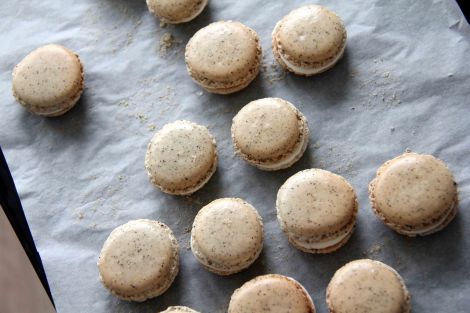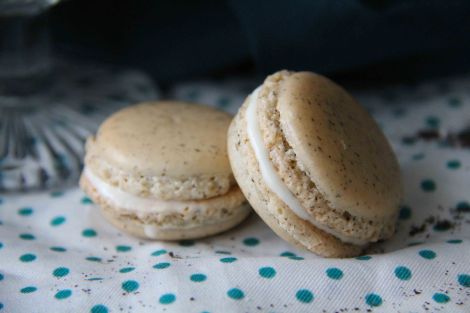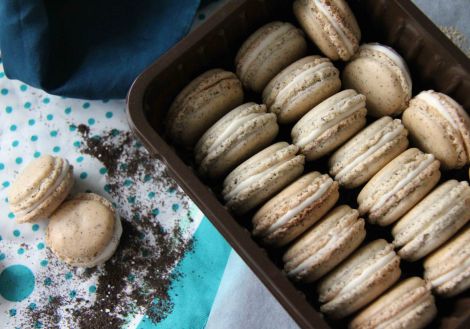French macarons are finicky little guys. Made with only four simple ingredients, it took three tries over the span of two weeks to finally get the perfect crisp-chewy shell with little feet, and MAN, was I elated. No more hiding those deformed, cracked shells at the back of the fridge (I snuck them in for a midnight snack). HUZZAH.
So, these are French macarons; and generally speaking, there are two methods of making these: French meringue, and Italian meringue. The latter involves making a sugar syrup and adding it to the beaten egg white gradually, whipping the entire thing to form glossy smooth peaks, whereas the former is the traditional style of beating egg whites with sugar to stiff peaks. Since I don’t own a sugar thermometer and am deathly afraid of burning sugar, burning the pot, burning my hand, and burning in general, I decided to go with the French meringue method. Now let’s talk ingredients.
Ground almonds: Some grind their own almonds using a food processor (such a dream! But woe, I am but a student), and some just buy ready-ground almond. It doesn’t matter which one you have available, but what’s important is to sift. Sift, sift, to be exact. Double sifting removes the larger particles of almond that will disrupt the smooth surface of your macaron and make your life burst into flames. It takes some time, but it’s well worth it.
Icing/ superfine sugar: I just use regular icing sugar. Now again, some may choose to pulse the icing sugar in a food processor to make sure it’s über fine. However, I just sift. Sift, sift.
Granulated sugar: Macaron recipes call for granulated sugar…. but I don’t have it. So I used caster sugar. Erm. I guess it worked?
Egg whites: WEIGH THEM. If not your life will burst into flames. Again.
I’m sorry for sounding aggressive, but there’s really no other way. I actually keep a stash of frozen egg whites in the freezer (from making egg-yolk-rich pastry yum yum) and ration them out to make meringue. Secondly, if your egg white is not room-temperature, bring them to room temperature by sitting your mixing bowl (containing said egg whites) in a bowl of warmish water. Thirdly (phew), some sources state to age your egg whites. Ageing is just letting the egg white sit on the counter or fridge for about 24 hours or so, to allow them to be slightly more liquid. I didn’t do this (I’ve cheated quite a bit it seems) and these turned out fine:)
I’m far from superb macaron making, but here are some technique tips that I’ve learnt:
1) A weighing scale. Is so very important. Digital, if possible.
2) Sifting. Sift, sift. (See above. I’ve officially mentioned ‘sift’ 10 times as of now. I am the Crazy Sifting Girl.)
3) Beat the egg whites, adding sugar gradually till stiff peaks. These should be glossy and smooth and look like the Alps exploded in your bowl in a glorious dollop. Turn the bowl upside down and the glorious Alps should not budge.
4) Macaronage. Sigh. The first time I over-folded and ended up with runny batter that cracked in the oven, yielding deformed macarons so unsightly that my fridge cried. It’s been described that the consistency of the batter should be like molten lava, and unfortunately I seem to think molten lava is much runnier than it is. The best way (I feel), is to fold slowly, checking the consistency consistently (ha) by dropping some onto a plate/ flat surface. The mixture should peak, then slowly even itself out, and by 1 minute or so, the entire dollop should be smooth. If it doesn’t, fold a few more times and check again. If it runs like a pancake batter, it’s overdone (yikes):/
5) Always line your trays with baking paper/ a silicon bake-sheet (this aids removal as well). Greasing the tray just cannot cut it.
6) Drying the macarons for an hour develops the glossy, crisp shell that is coveted. It also helps the feet form.
7) Baking. Always place your trays in the bottom most rack of your oven, so the macarons don’t get toasty and golden brown. We want pretty pastels, yes yes yes.
8) Removing. When macarons come out of the oven, wait for them to cool. I have itchy-fingers and always attempt to peel one off immediately but do not do this. Wait for them to cool (and harden), then peel the baking paper away from the macaron shells, not vice versa. Don’t peel the macaron away from the baking paper or else they might break. They are so so so very delicate.
9) Resting. Once filled, the macarons should be left (at least) overnight in the fridge for the flavours to combine and become a wonderful confection of crisp-chewy-melty. But do sneak one in straight after baking and filling. You deserve it!
And finally! The recipe!
EARL GREY MACARONS WITH CREAM CHEESE FROSTING
makes about 25 small-medium macaron shells
- 53g egg white
- 25g granulated/ caster sugar
- 100g icing/superfine sugar
- 60g ground almonds
- 1 earl grey tea bag
•••••
- Weigh out all the ingredients.
- Sift the ground almonds and icing sugar together. Do this twice.
- Cut open the earl grey teabag and empty contents into the almond-icing sugar mixture and combine (If your earl grey leaves are too big, grind them with a knife first). Set aside.
- In a squeaky clean and dry bowl, beat egg whites till foamy. Add half the caster sugar and beat till soft peaks. Add the rest of the caster sugar and beat till stiff peaks (smooth, glossy Alps!)
- Using a spatula, fold in half the almond-icing sugar-earl grey mixture gently. Then add the other half.
- When the ingredients are mostly incorporated, begin macaronage. Swiftly fold and press the mixture using light strokes, check for consistency (stated above) ever so often.
- Transfer to a piping bag with a small round tip/ use a plastic bag with the corner snipped off and pipe small circles, 1.5 inches in diameter, about 1.5 inches apart.
- Let them dry in the open for about an hour. The surface will become like a film and you can prod it (gently) with your finger without it sticking.
- Bake in a 150-160 degrees Celsius oven at the bottom rack for 18-20 minutes. Watch the little feet develop!:D
- Cool, and remove from baking sheet. Fill with a teaspoon of filling and refrigerate overnight.
Cream cheese frosting (makes more than needed)
- 100g full fat cream cheese
- 30g butter
- 150g icing sugar
•••••
- Beat the butter till light and fluffy, and add the cream cheese. Beat.
- Gradually add icing sugar and beat, until it reaches a desired consistency. Don’t overbeat or it’ll become runny.
Very wordy post (sorry) but er, I’ve peppered it with photos? Subtly floral earl grey with tangy cream cheese frosting! Without a doubt, perfect with a cup of earl grey tea. This takes practice, and third time was the charm, so just keep trying and you’ll be rewarded with a homemade macaron. Or rather, homemade macarons! Deeelish.
Here’s the recipe card:
xx, W








This sounds like a great flavor combination– love earl grey! For such a small treat, macarons can be quite intimidating… I feel a little more prepared to tackle them after reading this though.
LikeLike
Thanks margaret! Hope the tips helped and maybe I’ll see some macarons on your page soon:) Best of luck!
LikeLike
Pingback: Matcha Macarons with Bittersweet Chocolate Ganache | Whisk&Knife·
Pingback: french macarons | Creative Entertaining·
This recipe made the daunting macrons very, very easy. Well maybe that’s an exaggeration, but definitely manageable anyway. A few things I might add to her helpful instructions:
For starters, 25 macron shells only works out to about 12 filled macrons. A good amount if this is your first time making them, and you don’t want the ingredients to go to waste if you screw up. But if you’ve made macrons before and are confident, to me, this seems like such a small serving size, considering one could easily 2 or 3 in a sitting. For me, I did a practice run, and when I make them again for a friends bridal shower, I will likely triple or possibly quadruple the recipe.
She gives the baking temperature in Celsius. Pay attention and don’t start baking them at 160 Fahrenheit like I did. They’ll still turn out, they may just be slightly browner on top than idea.
The recipe makes far more frosting than is really necessary. I piped what looked like a reasonable amount onto each macron, realized I had about half my frosting left, and added more to each. I should have just left it, as that much frosting was overpowering (this coming from the person who straight up piped the last bit into my own mouth after I finished adding more to each). Just pipe what looks like a reasonable amount to you, and maybe save the rest?
LikeLike
That’s why we need readers like you, Theresa! Thanks so much for the comments! I do make macarons in small batches precisely because I’m afraid of screwing up. I do like freezing the extra frosting, you know, because we all need extra frosting sometimes 😉
LikeLike
No problem!! Do you happen to know how long these would keep for? I plan to make a huge batch for favours for a bridal shower this weekend, and I’d rather make them and package them up this week while I have time because my weekend is looking rather busy. Would they last longer if I freeze them or is that a no no?
LikeLike
I’ve kept them for about 5 days, and they were fine? It also helps that the flavours do meld together better after a day or two. I wouldn’t freeze them, not sure sure what defrosting (and condensation) might do to them! Good luck:D
LikeLike
Pingback: Chocolate-Cherry Heart shaped Macarons | Whisk&Knife·
Pingback: 2 New Macaron Flavours! | Abaissage avec Aaron·
Pingback: Upgraded Versions of 2 Previous Flavours! | Abaissage avec Aaron·
Pingback: Upgraded Versions of 2 Previous Flavours! | Café de Mac-Aaron·